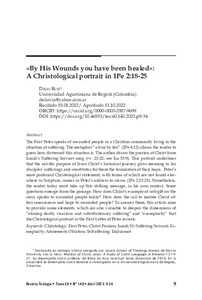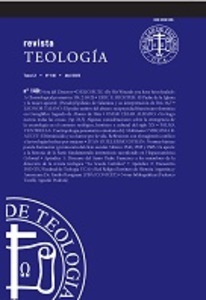Por favor, use este identificador para citar o enlazar este ítem:
https://repositorio.uca.edu.ar/handle/123456789/16218| Título: | «By His Wounds you have been healed» : a Christological portrait in 1Pe 2:18-25 «Gracias a sus heridas han sido sanados» : un retrato cristológico en 1Pe 2,18-25 |
Autor: | Ruiz, Delio | Palabras clave: | CRISTOLOGIA; SUFRIMIENTO; EXPIACION | Fecha de publicación: | 2023 | Editorial: | Pontificia Universidad Católica Argentina. Facultad de Teología | Cita: | Ruiz, D. «By His Wounds you have been healed» : a Christological portrait in 1Pe 2:18-25 [en línea]. Teología. 2023, 60 (140). doi: 10.46553/teo.60.140.2023.p9-34. Disponible en: https://repositorio.uca.edu.ar/handle/123456789/16218 | Resumen: | Abstract: The First Peter speaks of wounded people in a Christian community living in the
situation of suffering. The metaphor “a trial by fire” (1Pe 4:12) allows the reader to
guess how distressed this situation is. The author draws the passion of Christ from
Isaiah’s Suffering Servant song (vv. 21-22; see Isa 53:9). This portrait underlines
that the salvific purpose of Jesus Christ’s historical journey gives meaning to his
disciples’ sufferings and constitutes for them the foundation of their hope. Peter’s
most profound Christological statement, with terms of which are not found elsewhere
in Scripture, comes in Peter’s address to slaves (1Pe 2:22-25). Nonetheless,
the reader today must take up this striking message, in his own context. Some
questions emerge from the passage: How does Christ’s example of self-gift on the
cross speaks to wounded people today? How does the call to imitate Christ offers
reassurance and hope to wounded people? To answer them, this article aims
to provide some elements, which are also valuable to deepen the dimensions of
“atoning death, vicarious and substitutionary suffering” and “exemplarity” that
the Christological portrait in the First Letter of Peter reveals. Resumen: La Primera Carta de Pedro habla de las heridas en una comunidad cristiana que vive en el sufrimiento. La metáfora que describe esa “prueba de fuego” (1Pe 4:12) permite al lector adivinar lo angustioso de la situación. El autor esboza la pasión de Cristo evocando el cuarto cántico del Siervo Sufriente de Isaías (vv. 21-22; ver Isaías 53:9). Este retrato cristológico recalca que el propósito salvífico del camino histórico de Jesucristo da sentido a los sufrimientos de sus discípulos y constituye para ellos el fundamento de su esperanza. La afirmación cristológica de la Carta, conteniendo términos no se encuentran en ninguna otra parte de las Escrituras, sobreviene en el discurso de Pedro a los esclavos (1 Pe 2:22-25). Sin embargo, el lector de hoy debe retomar el mensaje, en su propio contexto. Algunas preguntas emergen del pasaje: ¿Cómo el ejemplo de Cristo, quien se entrega a sí mismo en la cruz, habla hoy a las personas heridas? ¿De qué manera la llamada a imitar a Cristo les ofrece consuelo y esperanza? Para responderlas, este artículo pretende aportar algunos elementos, los cuales también son valiosos para profundizar en las dimensiones de “expiación, muerte vicaria, sufrimiento sustitución” y “ejemplaridad” que el retrato cristológico de la Primera Carta de Pedro pone de manifiesto. |
URI: | https://repositorio.uca.edu.ar/handle/123456789/16218 | ISSN: | 0328-1396 (impreso) 2683-7307 (online) |
Disciplina: | TEOLOGIA | DOI: | 10.46553/teo.60.140.2023.p9-34 | Derechos: | Acceso abierto | Fuente: | Teología. 2023, 60 (140) |
| Aparece en las colecciones: | TEO - 2023 Tomo LX nro. 140 |
Ficheros en este ítem:
| Fichero | Descripción | Tamaño | Formato | |
|---|---|---|---|---|
| by-his-wounds.pdf | 881,11 kB | Adobe PDF |  Visualizar/Abrir | |
| cover_issue_469_es_AR.jpg | 11,71 kB | JPEG |  Visualizar/Abrir |
Visualizaciones de página(s)
53
comprobado en 27-abr-2024
Descarga(s)
110
comprobado en 27-abr-2024
Google ScholarTM
Ver en Google Scholar
Altmetric
Altmetric
Este ítem está sujeto a una Licencia Creative Commons

